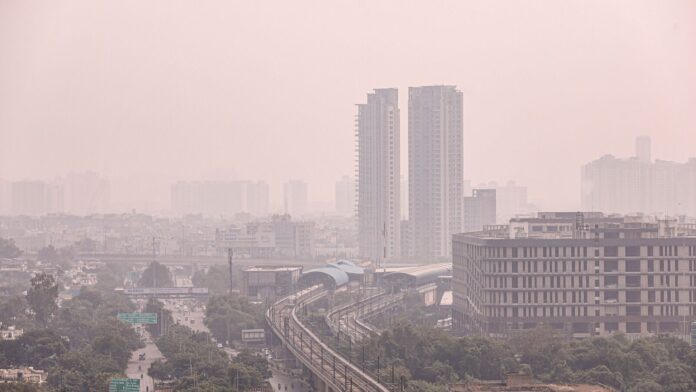With NCR’s Air Quality Index (AQI) crossing the 300 mark this month, the Commission for Air Quality Management (CAQM) and the Automotive Research Association of India (Arai) are deliberating on both fronts, according to two people aware of the matter.
The proposal aims to curb emissions from heavy machinery used in infrastructure projects — a significant but often-overlooked contributor to winter smog — and encourage wider EV adoption by easing access to charging points in residential societies.
Deliberations have recently begun with various stakeholders and think tanks. They have identified key sectors contributing to worsening air quality in Delhi-NCR, including transportation, waste management, and construction, said one of the people, requesting anonymity.
“Transportation is obviously one of these sectors. The aim is to find mandates for all the sectors that are identified,” the person said, adding that using electric construction equipment is under study.
The study will also assess market readiness — whether sufficient electric equipment is available. The aim is to find long-term solutions for Delhi-NCR’s worsening air quality, the second person added.
Email queries to ARAI and CAQM remained unanswered till press time.
Cleaner fuel shift in progress
The construction sector is already exploring cleaner fuels for typically diesel-heavy equipment such as cranes, excavators, and bulldozers, according to the Indian Construction Equipment Manufacturers’ Association (ICEMA).
Earlier, Mint reported the government’s focus on flex fuels for construction equipment, which accounts for about 3–4% of India’s annual 91 million tonnes of diesel use.
RWA resistance to chargers
Another key recommendation is to stop resident welfare associations (RWAs) from blocking EV charger installations in their premises. “This has long hindered EV adoption,” said one of the people cited above. Most consumers prefer overnight charging due to range anxiety, but many housing complexes still deny no-objection certificates (NOCs) despite clear policy support.
Range anxiety—the fear that an EV may not have sufficient charge to complete a journey—remains one of the biggest barriers to wider adoption.
The NITI Aayog, in its August 2025 report, noted that RWA resistance remains a top deterrent to EV adoption. The report said consultations with EV makers, charger producers, and operators found that RWAs routinely refuse permission for private and community charging points.
Delhi’s annual smog cycle
Delhi’s air quality plunges every October to December, often reaching ‘severe’ levels — above 400 AQI, per Central Pollution Control Board (CPCB) data. The city has breathed ‘poor’, ‘very poor’, or ‘severe’ air for over 40% of the year since 2022.
An AQI of zero to 50 is considered ‘good’, 51-100 ‘satisfactory’, 101-200 ‘moderate’, 201-300 ‘poor’, 301-400 ‘very poor’, and 401-500 ‘severe’.
Union transport minister Nitin Gadkari recently said at an auto industry meet that cutting vehicular emissions in Delhi-NCR is a top priority, noting that transport contributes around 40% of India’s total pollution.
Reducing vehicular emissions in Delhi is a challenge due to the sheer volumes of vehicles on the streets. In 2024-25, the Delhi transport department registered about 450,000 two-wheelers, a little over 190,000 cars, 2,300 buses, and about 17,200 trucks, according to Vahan, the central government’s registry of vehicles.
Experts say vehicular emissions and construction dust are Delhi’s biggest pollution sources.
“Suspended particulate matter, that is, dust particles contribute significantly to Delhi’s air pollution. Besides vehicular emissions, the construction sector contributes to the problem. Demolition of old buildings, and dumping the debris into landfills releases particles of various sizes into the air. In dry climates like Delhi, the fine particles remain airborne longer,” said Gurudas Nulkar, professor and director, Centre for Sustainable Development, Gokhale Institute of Politics and Economics.
Policy push and pull
These discussions come as federal policy think tank NITI Aayog in August asked the central government to push stricter mandates promoting cleaner mobility.
In the August report titled Unlocking a $200 Billion Opportunity: Electric Vehicles in India, the think tank said India’s adoption of electric vehicles was lower than that in other countries, and needed policy mandates instead of just incentives.
So far, central efforts have focused on subsidies and incentives — such as the ₹10,900 crore PM E-Drive and ₹25,938 crore PLI scheme for automobiles and parts — but not on hard regulations.
Meanwhile, the transport policy in Delhi has seen two major rollbacks in recent months. Delhi’s end-of-life vehicle fuel ban in July this year was rolled back within days of implementation after consumer outcry.
Also, Delhi government’s draft electric vehicle policy earlier this year caused an uproar among automakers when the government proposed equal incentives for hybrid and electric vehicles. The proposal split the auto lobby into two groups, with hybrid makers such as Maruti Suzuki India Ltd on one side, and electric vehicle makers such as Mahindra & Mahindra Ltd and Tata Motors Ltd on another.
Electric vehicle makers argued that since hybrid vehicles are a bridge technology which does not make zero-emission vehicles – while electric powertrains emit no pollutants at all – there should be no parity of incentives for the two types of vehicles.
The proposal has since been rolled back, and the policy is expected to be reworked by the end of FY26.
Delhi air quality,electric vehicles,pollution control measures,EV charger installations,construction sector emissions,Delhi pollution,CAQM,ARAI,electric construction equipment,RWA,EV chargers,NITI Aayog,hybrid vehicles,PM E-Drive,air quality,Gadkari
#Delhi #weighs #electric #construction #vehicles #easier #charging #fight #winter #smog

